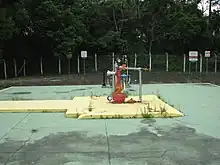| Candeias Oil Well | |
|---|---|
Poço de Petróleo de Candeias | |
 Monument in honor of the Candeias Oil Well C-1 | |
| General information | |
| Location | Candeias, Bahia |
| Coordinates | 12°42′18″S 38°34′00″W / 12.70500°S 38.56667°W |
The Candeias Oil Well (C-1), discovered on December 13, 1941, is located in the municipality of Candeias, in the interior of the state of Bahia.[1][2]
Context and discovery
Drilled on June 30, 1941, the Candeias Oil Well 1 (C-1) was the first commercial exploration well and the first oil field in Brazil.[3][4] Previously, on January 21, 1939, a well had been discovered in Lobato, a district of Salvador, but it was not commercially exploited. Both used the same drilling machine. Work began on April 2, 1941, but drilling only took place in June and was completed on December 31, 1941.[5][6][7][8]
The exploration of oil in Brazil dates back to the government of Pedro II, when he granted permission to the Englishman Thomas Denny Sargent to extract oil and other minerals in the south of Bahia.[9][10] In 1892, drilling was carried out by Eugênio Camargo, who only managed to extract clayey sand. In 1907, the Mineralogical Service of Brazil joined the research and increased the areas under analysis.[11][12]
Landulpho Alves Refinery

In the 1940s, the Bahia Oil Workers' Union (Sindipetro) reported that the discovery and development of oil in Candeias sparked the creation of a refinery.[13] In 1950, the Landulpho Alves Refinery (now Mataripe Refinary), was set up in the municipality of São Francisco do Conde, near Candeias.[14][15][16][7]
The increase in oil production led to the creation of the state-owned company Petrobras in 1953 by then president Getúlio Vargas, established after a popular campaign called "O Petróleo é Nosso" (English: Oil is Ours). Until 1965, Bahia was the only state in the country to produce oil.[17][15][10] After the discovery of the first well, others were found in and around Candeias. C-2, found two months after C-1, produced up to 80 barrels a day, an by 1951, it had produced 22,768.03 barrels of oil and 75.515 barrels of gas.[7][4][16] On June 23, 1952, President Getúlio Vargas visited Candeias, where he made his official speech in defense of the state oil monopoly and the creation of Petrobras.[18][4]
Monument
The well was listed as a historical landmark by the Artistic and Cultural Heritage Institute of Bahia (IPAC), the organization responsible for preserving Bahia's memory and culture, given its importance for the construction of Petrobras. Next to the well, Petrobras built a monument to commemorate and honor the first oil workers.[2][10]
See also
References
- ↑ "Petrobras comemora 70 anos do poço Candeias-1 em Salvador". TN Petróleo. 2011-12-19. Retrieved 2021-07-27.
- 1 2 "Poço de Petróleo de Candeias (C-1)". SIPAC. Retrieved 2023-12-07.
- ↑ "Petrobras 55 anos. O ouro negro do Brasil". Força Sindical. 2010-11-10. Retrieved 2021-07-27.
- 1 2 3 Santos, Jair Cardoso (2008). Candeias: História de Terra do Petróleo. Salvador: Gráfica Salesiano.
- ↑ Cruz, Leonardo (2019-10-04). "O óleo de Lobato: a primeira jazida de petróleo brasileira". Brasil de Fato. Retrieved 2021-07-27.
- ↑ "Há 75 anos era descoberto petróleo em Lobato, bairro de Salvador (BA)". G1. 2014-01-21. Retrieved 2021-07-27.
- 1 2 3 Oliveira, Alessandra (2019-10-21). "Poço de incertezas: da origem do petróleo à insegurança sobre a atuação da Petrobras na Bahia". A Tarde. Retrieved 2023-08-17.
- ↑ Gomes, Donaldson (2019-04-07). "Briga de vizinhos no Lobato deu início à saga do petróleo no Brasil". Correio 24 Horas. Retrieved 2023-08-17.
- ↑ Lucchesi, Celso Fernandes. "Petróleo". Dossiê Recursos Naturais (12 ed.).
- 1 2 3 Morais, José Mauro (2023). "Petróleo em águas profundas" (PDF). IPEA (2).
- ↑ "Fazendeiro paulista fez primeira tentativa de achar petróleo no Brasil". Agência Brasil. 2006-04-21. Retrieved 2021-07-27.
- ↑ "Serviço Geológico e Mineralógico do Brasil". Memória da Administração Pública Brasileira. 2019-12-05. Retrieved 2021-07-27.
- ↑ "Vendida por US$ 1,65 bilhão, Landulpho Alves é a 1ª refinaria nacional". G1. 2021-02-08. Retrieved 2021-07-27.
- ↑ "Rlam: 50 anos cada vez mais refinados". Revista Petro & Química. No. 222. 2000.
- 1 2 Vasconcelos, Levi (2020-11-06). "E a Petrobras começa dar adeus à Bahia, onde o petróleo era nosso". A Tarde. Retrieved 2023-08-17.
- 1 2 "O primeiro Campo comercial de petróleo do Brasil e o sonho da independência econômica e da soberania nacional". Sindipetro. 2019-07-31. Retrieved 2021-07-25.
- ↑ "Com fechamento de campos terrestres, Castello Branco acelera efeito dominó para destruição da Petrobrás". FUP. 2020-05-12. Retrieved 2021-07-27.
- ↑ Amado, Aécio (2006-04-21). "Foto de Vargas com mão suja de óleo foi símbolo da campanha O Petróleo é Nosso". Agência Brasil. Retrieved 2021-07-27.